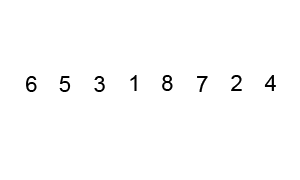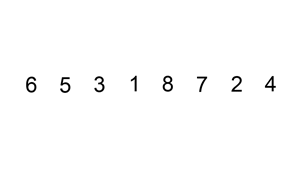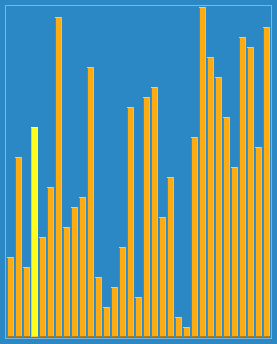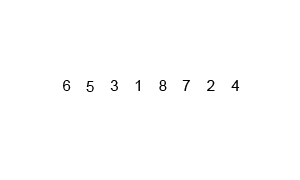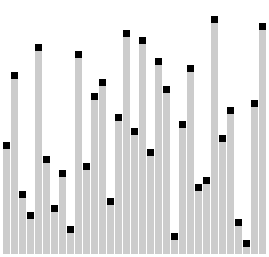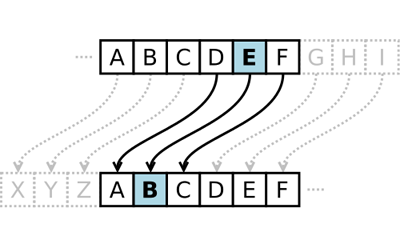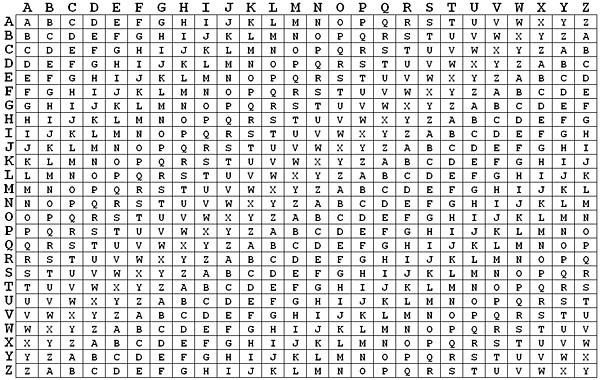All algorithms are implemented on Python. For the execution of algorithms, the standard Python library version 3.6 is required. These algorithms are need for practice Python, a better understanding of algorithms and education the programming.
- Algorithm.
In mathematics and computer science, an algorithm is an unambiguous specification of how to solve a class of problems. Algorithms can perform calculation, data processing and automated reasoning tasks.
Source: Wikipedia
- Computer algorithm.
In computer systems, an algorithm is basically an instance of logic written in software by software developers to be effective for the intended "target" computer(s) to produce output from given (perhaps null) input. An optimal algorithm, even running in old hardware, would produce faster results than a non-optimal (higher time complexity) algorithm for the same purpose, running in more efficient hardware; that is why algorithms, like computer hardware, are considered technology.
Source: Wikipedia
In computer science, a sorting algorithm is an algorithm that puts elements of a list in a certain order. The most-used orders are numerical order and lexicographical order. Efficient sorting is important for optimizing the use of other algorithms (such as search and merge algorithms) which require input data to be in sorted lists; it is also often useful for canonicalizing data and for producing human-readable output.
Source: Wikipeadia
Bubble sort, sometimes referred to as sinking sort, is a simple sorting algorithm that repeatedly steps through the list to be sorted, compares each pair of adjacent items and swaps them if they are in the wrong order. The pass through the list is repeated until no swaps are needed, which indicates that the list is sorted.
Source: Wikipedia
Insertion sort is a simple sorting algorithm that builds the final sorted array (or list) one item at a time. It is much less efficient on large lists than more advanced algorithms such as quicksort, heapsort, or merge sort.
Source: Wikipedia
It is a sorting algorithm which is similar to insertion sort, except that moving an element to its proper place is accomplished by a series of swaps, as in bubble sort. It is conceptually simple, requiring no nested loops.
Source: Wikipedia
Cocktail shaker sort, also known as bidirectional bubble sort, cocktail sort, shaker sort (which can also refer to a variant of selection sort), ripple sort, shuffle sort, or shuttle sort, is a variation of bubble sort that is both a stable sorting algorithm and a comparison sort.
Source: Wikipedia
Insertion sort is a simple sorting algorithm that builds the final sorted array (or list) one item at a time. It is much less efficient on large lists than more advanced algorithms such as quicksort, heapsort, or merge sort.
Source: Wikipedia
In computer science, selection sort is a sorting algorithm, specifically an in-place comparison sort. It has O(n2) time complexity, making it inefficient on large lists, and generally performs worse than the similar insertion sort. Selection sort is noted for its simplicity, and it has performance advantages over more complicated algorithms in certain situations, particularly where auxiliary memory is limited.
Source: Wikipedia
Shellsort, also known as Shell sort or Shell's method, is an in-place comparison sort. It can be seen as either a generalization of sorting by exchange (bubble sort) or sorting by insertion (insertion sort).
Source: Wikipedia
Bucket sort, or bin sort, is a sorting algorithm that works by distributing the elements of an array into a number of buckets. Each bucket is then sorted individually, either using a different sorting algorithm, or by recursively applying the bucket sorting algorithm.
Source: Wikipedia
Quicksort (sometimes called partition-exchange sort) is an efficient sorting algorithm, serving as a systematic method for placing the elements of an array in order. Developed by Tony Hoare in 1959 and published in 1961, it is still a commonly used algorithm for sorting.
Source: Wikipedia
Comb sort is a relatively simple sorting algorithm originally designed by Włodzimierz Dobosiewicz in 1980. Later it was rediscovered by Stephen Lacey and Richard Box in 1991. Comb sort improves on bubble sort.
Source: Wikipedia
Stooge sort is a recursive sorting algorithm. The running time of the algorithm is thus slower compared to efficient sorting algorithms, such as Merge sort, and is even slower than Bubble sort, a canonical example of a fairly inefficient and simple sort.
Source: Wikipedia
In computer science, a search algorithm is any algorithm which solves the search problem, namely, to retrieve information stored within some data structure, or calculated in the search space of a problem domain. Examples of such structures include but are not limited to a linked list, an array data structure, or a search tree. The appropriate search algorithm often depends on the data structure being searched, and may also include prior knowledge about the data. Searching also encompasses algorithms that query the data structure, such as the SQL SELECT command.
Source: Wikipeadia
In computer science, linear search or sequential search is a method for finding a target value within a list. It sequentially checks each element of the list for the target value until a match is found or until all the elements have been searched.
Source: Wikipedia
In computer science, binary search, also known as half-interval search, logarithmic search, or binary chop, is a search algorithm that finds the position of a target value within a sorted array.
Source: Wikipedia
Interpolation search is an algorithm for searching for a given key in an indexed array that has been ordered by numerical values assigned to the keys (key values). It parallels how humans search through a telephone book for a particular name, the key value by which the book's entries are ordered. In each search step it calculates where in the remaining search space the sought item might be, based on the key values at the bounds of the search space and the value of the sought key, usually via a linear interpolation. The key value actually found at this estimated position is then compared to the key value being sought. If it is not equal, then depending on the comparison, the remaining search space is reduced to the part before or after the estimated position. This method will only work if calculations on the size of differences between key values are sensible.
Source: Wikipedia
Cryptography is the practice and study of techniques for secure communication in the presence of third parties called adversaries. More generally, cryptography is about constructing and analyzing protocols that prevent third parties or the public from reading private messages; various aspects in information security such as data confidentiality, data integrity, authentication, and non-repudiation are central to modern cryptography. Modern cryptography exists at the intersection of the disciplines of mathematics, computer science, electrical engineering, communication science, and physics. Applications of cryptography include electronic commerce, chip-based payment cards, digital currencies, computer passwords, and military communications.
Source: Wikipeadia
RSA (Rivest–Shamir–Adleman) is one of the first public-key cryptosystems and is widely used for secure data transmission. In such a cryptosystem, the encryption key is public and it is different from the decryption key which is kept secret (private). In RSA, this asymmetry is based on the practical difficulty of the factorization of the product of two large prime numbers, the "factoring problem". The acronym RSA is made of the initial letters of the surnames of Ron Rivest, Adi Shamir, and Leonard Adleman, who first publicly described the algorithm in 1978. Clifford Cocks, an English mathematician working for the British intelligence agency Government Communications Headquarters (GCHQ), had developed an equivalent system in 1973, but this was not declassified until 1997.
Source: Wikipedia
In cryptography, a Caesar cipher, also known as Caesar's cipher, the shift cipher, Caesar's code or Caesar shift, is one of the simplest and most widely known encryption techniques. It is a type of substitution cipher in which each letter in the plaintext is replaced by a letter some fixed number of positions down the alphabet.
Source: Wikipedia
The Gronsfeld cipher is a variant created by Count Gronsfeld which is identical to the Vigenère cipher, except that it uses just 10 different cipher alphabets (corresponding to the digits 0 to 9). The Gronsfeld cipher is strengthened because its key is not a word, but it is weakened because it has just 10 cipher alphabets. Gronsfeld's cipher did become widely used throughout Germany and Europe, despite its weaknesses.
Source: Wikipedia
Morse code is a method of transmitting text information as a series of on-off tones, lights, or clicks that can be directly understood by a skilled listener or observer without special equipment. It is named for Samuel F. B. Morse, an inventor of the telegraph. The International Morse Code encodes the ISO basic Latin alphabet, some extra Latin letters, the Arabic numerals and a small set of punctuation and procedural signals (prosigns) as standardized sequences of short and long signals called "dots" and "dashes", or "dits" and "dahs", as in amateur radio practice.
Source: Wikipedia
The Vigenère cipher is a method of encrypting alphabetic text by using a series of interwoven Caesar ciphers based on the letters of a keyword. It is a form of polyalphabetic substitution.
Source: Wikipedia
In cryptography, the Polybius square, also known as the Polybius checkerboard, is a device invented by the Ancient Greek historian and scholar Polybius, for fractionating plaintext characters so that they can be represented by a smaller set of symbols.
Source: Wikipedia
Sincerely, Ilyas Salimov.
Email: ilyas.salimov.07@gmail.com

